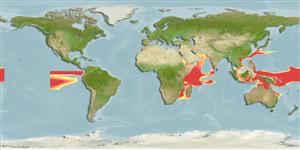Teleostei (teleosts) >
Stomiiformes (Lightfishes and dragonfishes) >
Stomiidae (Barbeled dragonfishes) > Astronesthinae
Etymology: Astronesthes: Greek, astra = ray + Greek, esthes, -es = suit, something used to wrap (Ref. 45335); tchuvasovi: Named after Vladimir Mikhailovich Chuvasov, the leading technician of the Lab. Of Oceanic Ichthyofauna (IORAN), who is a diligent member of staff of the Laboratory and the author's companion on many research cruises (Ref. 27676).
Eponymy: Vladimir Mikhailovich Chuvasov was the leading technician of the Laboratory of Oceanic Fauna, P P Shirshov Institute of Oceanology, Moscow. He was the authors’ companion on many research cruises. (Ref. 128868), visit book page.
Environment: milieu / climate zone / depth range / distribution range
Ecology
Marine; pelagic-oceanic. Tropical
Indo-Pacific: southern part of the Arabian Sea, the Flores and Banda seas, and the equatorial Eastern Pacific.
Size / Weight / Age
Maturity: Lm ? range ? - ? cm
Max length : 6.1 cm SL male/unsexed; (Ref. 42080)
Short description
Identification keys | Morphology | Morphometrics
Dorsal soft rays (total): 15 - 16; Anal soft rays: 13 - 14; Vertebrae: 46 - 48. In fish measuring 6 cm SL or more, aggregation of luminous tissue on head appear as a band across gill cover; one or several luminous patches on flanks, close to the medial line of body in advance of pelvic fin insertion. Chin barbel shorter than head, its swollen tip forming wide flattened lobe with oblique ribs and with small medial notch. It differs from other species of the group in having more vertebrae (Ref. 27676).
Life cycle and mating behavior
Maturity | Reproduction | Spawning | Eggs | Fecundity | Larvae
Parin, N.V. and O.D. Borodulina, 1996. Revision of the Astronesthes indicus species group (Astronesthidae), with descriptions of five new species. J. Ichthyol. 36(8):551-565. (Ref. 27676)
IUCN Red List Status (Ref. 130435: Version 2024-2)
Threat to humans
Harmless
Human uses
Tools
Special reports
Download XML
Internet sources
Estimates based on models
Preferred temperature (Ref.
123201): 20.9 - 28.6, mean 26.5 °C (based on 73 cells).
Phylogenetic diversity index (Ref.
82804): PD
50 = 0.5000 [Uniqueness, from 0.5 = low to 2.0 = high].
Bayesian length-weight: a=0.00417 (0.00171 - 0.01014), b=3.05 (2.84 - 3.26), in cm total length, based on LWR estimates for this (Sub)family-body shape (Ref.
93245).
Trophic level (Ref.
69278): 3.5 ±0.6 se; based on size and trophs of closest relatives
Resilience (Ref.
120179): High, minimum population doubling time less than 15 months (Preliminary K or Fecundity.).
Fishing Vulnerability (Ref.
59153): Low vulnerability (10 of 100).
